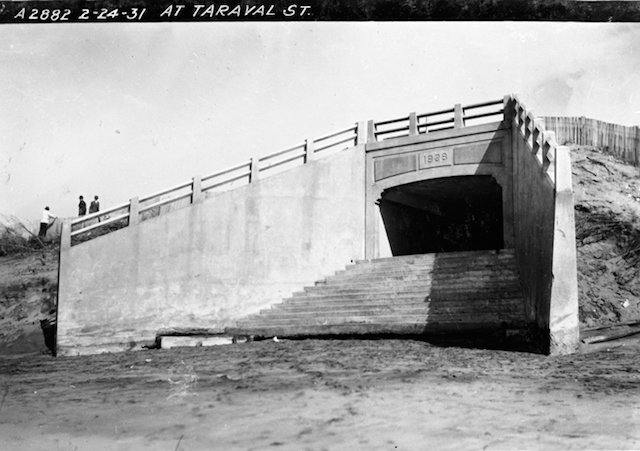Rarely are the sands of time quite so literal as they are at Ocean Beach. There, recent erosion has laid bare a long history of projects to bolster the beachhead against that very force: The waves that day by day erode and shape the shore.
A report from the Chronicle drawing on resources from Open SF History's Western Neighborhoods Project recalls several efforts to fight erosion that, in a nice bit of irony, have been recently disinterred by the Pacific and even the forces of El Niño.
According to the Municipal Employee magazine in 1929, the Great Highway along the Pacific was “The finest stretch of highway ever constructed." However, the "enduring concrete which will render for all time from the destructive effects of the ocean’s activities,” was not what it purported to be, and in time a wooden seawall replaced it. That was destroyed by stormy weather in 1939, but the wood has resurfaced and is now visible. The next seawall, built in 1939 from concrete, met a similar fate and is also now visible, as it has been since last month.
When cemeteries were relocated to Colma from San Francisco in 1943, tombstones and concrete were also used in an attempt to keep the beach in place. Those were stacked near Pacheco Street and have, yep, resurfaced in the last few years.
Are those the objects pictured above in an Instagram shot by photojournalist Beck Diefenbach? Asking for me.
Here's one that more clearly is:
Also buried in the sands but seeing a new, literal resurgence: A very cool 1920s pedestrian tunnel constructed at the end of Taraval Street underneath the Great Highway. That was taken apart about 40 years ago, but here's what it looked like.

The stairs down can be seen — for now. Perhaps take a look before storms return again.
Related: Ocean Beach Fires To Remain Free: $35 Permit Proposal Rejected
via the Western Neighborhoods Project, OpenSFHistory

